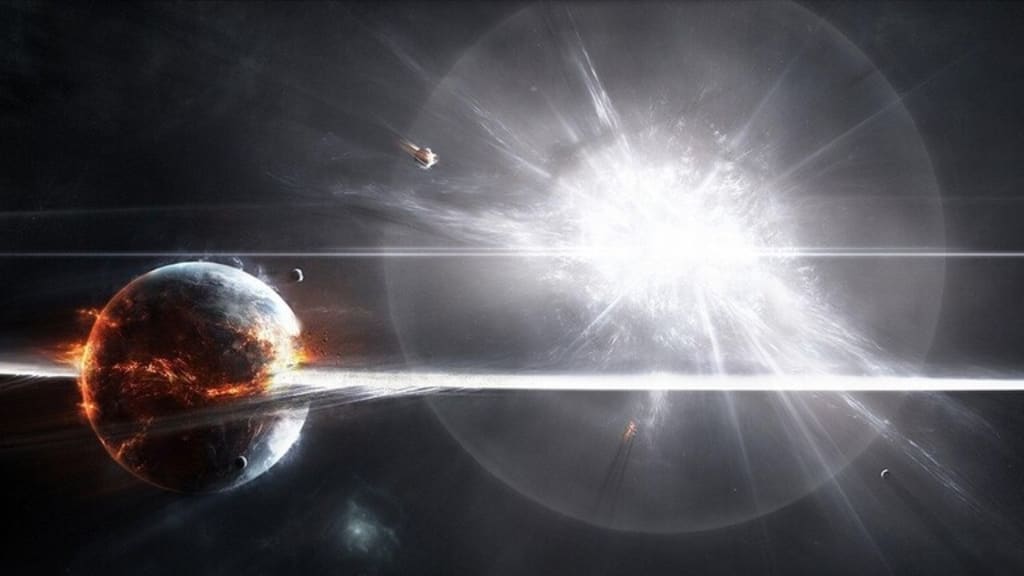For the first time, American astronomers record a star colliding with its planet
American astronomers recorded for the first time a flash inside the Milky Way galaxy, which arose as a result of a planet colliding with a star in the constellation of the Eagle.

And the subsequent absorption of the remains of the destroyed world by this star. This was announced on Wednesday, May 3, by the press service of the Association of Universities that conduct astronomical research.
"We have witnessed what awaits Earth in the distant future," said Kechalay D, a researcher at the Massachusetts Institute of Technology. "If the inhabitants of other planets observe this process from a similar distance, about 10 thousand light years, they will also see a bright flash on the surface of the sun, as if "It suddenly throws part of its matter into space. And then they will see how a giant cloud of dust will appear around the star."
Over the past two decades, astronomers have discovered more than 10,000 planets orbiting distant stars, including Earth-like planets and other worlds in the solar system. A large part of these outer worlds are located at a very short distance from their stars, and as a result we see them doomed to be destroyed more often by stars as they age and turn into red giants.
As Kechalai D and colleagues explain, the death of these worlds will come because temperatures in the cores of all sun-like stars gradually rise as their hydrogen reserves are depleted. This leads to a gradual expansion of the outer limits of the star and the absorption of nearby planets. Our planet and other planets await a similar fate, according to most astronomers, after about 7-7.5 billion years.
Subsequent analysis of images of the star, taken at the time of the flash's formation, indicated that the sharp increase in the star's brightness was accompanied by an ejection of material whose total mass was about 33-34 times that of Earth. The researchers hypothesized that such an expulsion of matter resulted from the star's collision with a Jupiter-sized planet and the subsequent destruction of this outer world.
Di and his colleagues said that the images and data collected while observing this cosmic event will help astronomers discover other examples of planets and stars colliding in near space. The discovery's authors concluded that their observations would allow scientists to determine how often sun-like stars destroy nearby planets. Source: TASS
Dean of the University of Tehran: Iran and Russia are developing a satellite for scientific research
Dean of the University of Tehran, Mohammad Muqimi, announced that his country is cooperating with Russia to develop a satellite for scientific research.
On the subject, Muqimi said: “The University of Tehran is cooperating with the Space College of Moscow University to develop a satellite for scientific research, and the implementation of the operational plans for this project will begin within the next two weeks. There are agreements with the Space College of Moscow University, and we visited the Russian Space Museum, so we will soon see that The University of Tehran will operate a joint satellite with the Russians in the field of scientific research.
"A preliminary agreement has been reached on financial issues, Operational procedures are scheduled to begin in the next two weeks so that we can send a joint scientific research satellite into space in the near future," he added.
Muqimi pointed out that "the universities of Tehran and Moscow agreed to continue cooperation in scientific and educational activities and to grant official certificates to students."
Regarding the results of the meetings of the heads of Russian and Iranian universities that took place recently, he said: "We have concluded new agreements with Moscow University on the exchange of students and professors. We have witnessed the great interest of Russian students to visit Iran. The grounds are ready for this visit. The University of Tehran will host these students in the summer for two months, to visit some universities in Iran." Source: irna.ir
Residents of many regions of Russia and the world will see the lunar eclipse today
The Planetarium Astronomical Center in Moscow announced that the "near total" eclipse of the moon that will occur today will be visible in several regions of Russia and the world.
And a statement issued by the center said: "On Friday, the moon will enter the Earth's shadow, and observers in most parts of Russia, with the exception of the Taimyar and Chukotka regions, will be able to witness the phenomenon of the (nearly total) lunar eclipse."
The statement added, "The eclipse will last from 18:14 to 22:31 Moscow time. The moon at this time will be in the constellation Libra. The eclipse will be visible from wherever the moon appears above the horizon in that period."
The statement indicated that the aforementioned phenomenon will be visible to the population of many regions of the world as well, such as the population of Antarctica, most of the population of Asia, southeastern Europe, Russia, Australia, Africa, and the population of the Pacific, Atlantic and Indian oceans. Source: TASS
A "false eclipse" adorns the earth's sky on the fifth of May
Astronomy lovers are preparing for the sky to host an exciting astronomical event on Friday, May 5, when the moon will enter the semi-shadow region of the Earth, creating an event known as a "semi-shadow eclipse."
During a penumbral eclipse, also known as a "false eclipse," skywatchers will see a slight darkening of the moon's surface. A semi-shadow eclipse occurs when the moon enters an area close to the earth's shadow called the "semi-shadow". The earth's shadow does not fall on the moon, nor does a real eclipse occur to it, but its illumination has dimmed by about 10%.
The lunar eclipse will begin at 15:15 GMT, and it will be visible in several regions of the world where the moon is on the horizon, including Antarctica, Asia, Russia, Oceania, and eastern and central Africa.
The event will culminate at 17:24 GMT and end at 19:32 GMT, when the Moon emerges from Earth's shadow.
The penumbra is the area where part of the sun's light is blocked from the moon, and this means that when the moon is inside the darkness, it receives less light from the sun and is dimmer but remains somewhat luminous.
According to In the Sky, the penumbral eclipse will not be visible at all from North America, South America or most of Europe.
Like every lunar eclipse, a penumbral eclipse occurs as a result of the earth passing between the moon and the sun and the three bodies being in a straight line.
This results in our planet's shadow falling on the face of the Moon as the Earth blocks light from the Sun. This can lead to events that can be subtle and difficult to observe, unlike solar eclipses.
The last time a penumbral eclipse was seen from the United States was on November 30, 2020, and the next time such an event will be visible from this region of the world on March 25, 2024. Source: Myspace
About the Creator
News Correct
Information WorldWide MORE INFORMATION






Comments
There are no comments for this story
Be the first to respond and start the conversation.